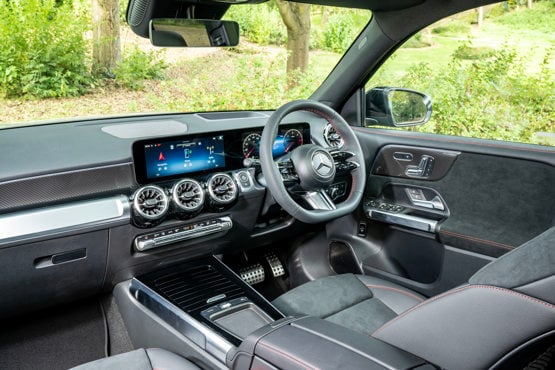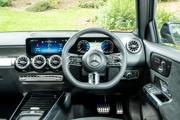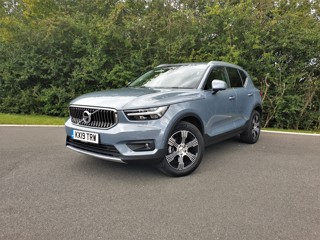Review
The GLB is one of the most practical models in the Mercedes-Benz line-up. It’s unique in offering a premium badge, seven seats and a compact footprint.
We like the way it looks and the way it drives but with only petrol and diesel engines available, we think the benefit-in-kind costs may deter a lot of company car drivers.
Overview
Mercedes-Benz has capitalised significantly on its compact car platform and offers a wide range of models that all share the same architecture and powertrains. It all started with the relatively straightforward A-Class hatchback, which later spawned a saloon variant, the CLA four-door coupe and Shooting Brake estate, the B-Class MPV, the GLA SUV and now the GLB.
The GLB is the largest car to share the A-Class’s platform, offering seven seats in a compact-yet-practical SUV body. It has a boxy and purposeful look, that sets it apart from the svelte saloons and coupes in the rest of the Mercedes line-up.
While the exterior presents a rugged appearance, stepping inside reveals an upmarket and eye-catching cabin that’s well appointed. The silver air vents and switchgear contrast well with the darker plastics and at night everything is bathed in light.
The GLB is available with two- or four-wheel-drive and prices range from £38,055 to £55,780. There are four trim levels – Sport Executive, AMG Line Executive, AMG Line Premium and AMG Line Premium Plus – alongside a performance-oriented AMG version.
There’s no plug-in hybrid powertrain available in the GLB, but Mercedes does offer the fully electric EQB. You can read more about the EQB here.
Comfort and practicality
The GLB is a family-focused model that competes alongside cars like the Nissan Qashqai and Kia Sportage. Its seven-seat layout means it offers a similar level of useability to larger vehicles, like the Skoda Kodiaq and Land Rover Discovery Sport.
While the rearmost seats are only really suitable for children and take up most of the boot space when in use, the rest of the passenger cabin is spacious. There’s ample legroom for those in the front and middle rows, making the GLB a great car for long distance trips. Extra roominess comes courtesy of the GLB’s tall profile, which provides headroom for even the tallest of occupants.

The third row of seats can be folded flat into the floor when not required, opening up a capacious boot. There’s 500-570 litres of space, depending on model, which is on par with key rivals in the segment.
All versions come with heated front seats and adjustable lumbar support as standard.
Safety and technology
The Mercedes A-Class set a new standard for in-car infotainment systems when it debuted the MBUX interface in 2018. The system has since been rolled out across the brand’s line-up and all models in the A and B family benefit from the twin-screen setup, which incorporates an intelligent voice control system.
In the GLB the central touchscreen measures 10.25-inches, while a second display of the same size sits in front of the driver as a digital instrument cluster. The two screens are mounted on a single panel, giving a panoramic view.
The system incorporates sat-nav, DAB, Bluetooth and smartphone integration via Apple CarPlay and Android Auto.
On AMG Line Premium grade, and above, there’s also an augmented reality navigation view, which uses real-time images from the forward-facing camera and overlays it with arrows and instructions.

As standard, the GLB comes equipped with front and rear parking sensors and a rear-view camera.
Euro NCAP awarded the GLB a five-star safety rating. The majority of safety-related features are fitted across the line-up, including autonomous emergency braking and lane keep assist.
The optional Driver Assistance Package adds adaptive cruise control and blind spot monitoring, as well as a host of other systems to prevent collisions. These systems can assist with lane changes, adapt to speed limit changes and provide support during evasive manoeuvres.
Driveability and efficiency
Mercedes has limited the GLB’s powertrain line-up to two petrol and two diesel engines. The entry-level GLB 200 uses a 1.3-litre four-cylinder petrol engine with a mild-hybrid system. It delivers 163PS to the front wheels and emits from 160g/km of CO2. Fuel economy of around 40mpg should be expected.
The GLB 200d is a more efficient powertrain. The 150PS unit has the lowest CO2 emissions in the range, starting from 148g/km. It should also achieve close to 50mpg.
A more powerful GLB 220d is offered in conjunction with 4Matic all-wheel-drive. It provides 190PS, while CO2 emissions rise to 158g/km. Fuel efficiency drops slightly, but should still be in the mid-40s.
At the top of the range sits the GLB 35 AMG. This flagship variant has a power output of 306PS, enough to shift the SUV from 0-62mph in 5.5 seconds. It’s the least efficient of the bunch, with CO2 emissions of 207g/km and around 30mpg.
Using a small hatchback platform to underpin a seven-seat SUV might not sound like a particularly wise move, but the GLB delivers impressive driveability. It’s exceptionally smooth and provides good levels of refinement. There’s a degree of agility too, although don’t expect high levels of engagement. The steering is very light and quite quick, which helps to make the GLB feel lighter and more nimble around town.
We found the GLB 220d to offer the best mix of performance and efficiency, while also giving the added confidence of all-wheel-drive. Front-driven GLBs have a tendency to scrabble for grip, especially when paired with the revvy 1.3-litre petrol engine.
Throttle response across the line-up is a tad sensitive, which means the GLB surges away from a standstill but, with the exception of the AMG variant, then feels a little lacking in grunt the faster you go.
Company car tax and running costs
With no plug-in hybrid variant on offer, the GLB is a less attractive company car proposition than a lot of other SUVs owing to its higher benefit-in-kind tax rate.
For those that need a seven-seater, however, it’s still a cost-effective choice.
The GLB 200d is the cheapest option for drivers, attracting bills of £221 per month for a 20% taxpayer. Running costs are reasonable for fleets, at 46p per mile.
Comparatively, the EQB 300 will cost just £18 per month in tax but it has a starting price that is £15,000 higher and running costs of 60p per mile.
Specs
| Manufacturer | Mercedes |
| Model | GLB Diesel Estate |
| Specification | Mercedes GLB Diesel Estate GLB 200d Sport Executive 5dr 8G-Tronic |
| Model Year | 2023.00 |
| Annual VED (Road tax) | £540 |
| BIK List Price | £39,825 |
| CO2 | 148g/km |
| BIK Percentage | 34% |
| Insurance Group | N/A |
| CC | 1,950 |
| Fuel Type | Diesel |
| Vehicle Type | Compact SUV |
| Luggage capacity (Seats up) | 570litres |
| Doors | 5 |
Running Costs
| P11D | £39,825 |
| Cost per mile | 53.95ppm |
| Residual value | £18,975 |
| Insurance group | N/A |
| Fuel Type | Diesel |
| Cost per mile | 139.22ppm |
| Fuel | 14.25ppm |
| Depreciation | 122.30ppm |
| Service maintenance and repair | 2.67ppm |
Rivals
Info at a glance
-
P11D Price
£39,825
-
MPG
50.4 (WLTP) -
CO2 Emissions
148g/km -
BIK %
34% -
Running cost
3 Year 60k : £18,975 4 Year 80k : £15,800 -
Fuel Type
Diesel
















 Diesel
Diesel

















